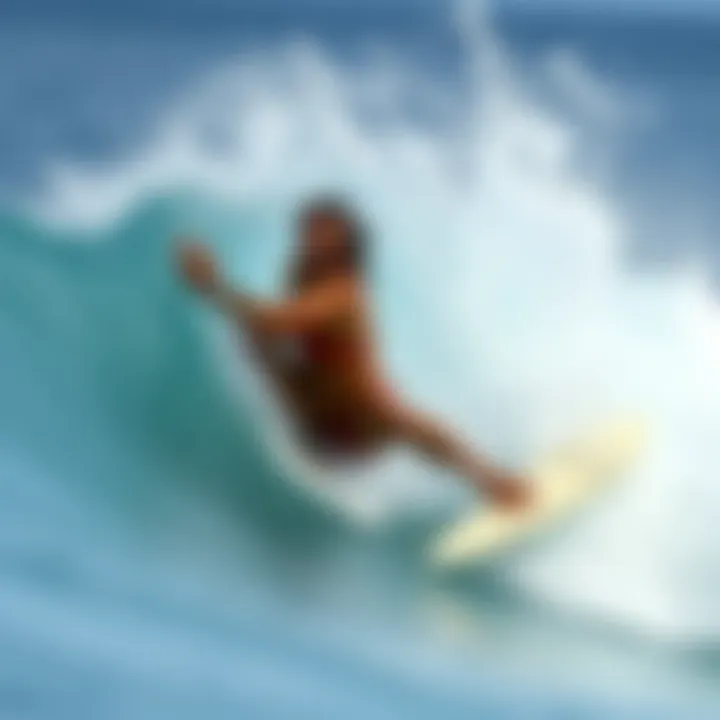Exploring Surfing Insights Through Community Surveys


Intro
Surfing is not just a sport; it’s a way of life for many. Whether you grew up riding the waves or are just starting to dip your toes into the ocean, understanding the intricacies of surf culture, techniques, and conservation efforts can enhance your experience. This article is a journey into the heart of surfing through structured surveys, intending to peel back layers of perceptions and preferences within the surfing community. Through this exploration, we’ll find out what drives individuals to catch waves and the essential aspects of gear that define their journeys. By looking closely at survey data, we aim to reveal the trends and insights that resonate with surfers from all walks of life.
Isn’t it fascinating how something as simple as a wave can have such depth? We will discover how various techniques and equipment can shape the surfing experience, but also how the community approaches critical issues like ocean conservation.
By the end, you’ll gain not just an understanding, but a nuanced perspective on what surfing means to many—be it thrill-seekers, environmental advocates, or enthusiasts of all kinds. This is your invitation to dive deep. Let's get started.
Prelude to Surf Surveys
Surf surveys present a fascinating window into the multifaceted world of surfing, weaving together the experiences, preferences, and values of a community that thrives on the waves. In this era where data-driven insights are pivotal, the role of surveys in understanding surf culture cannot be overstated. Diving deep into the motives behind surfing, surf surveys not only capture the essence of individual experiences but also help illustrate broader trends and shifts within the surfing community.
Purpose of Surf Surveys
The primary purpose of surf surveys is to gather valuable information regarding the choices and preferences of surfers across various demographics. Such surveys can encompass a variety of topics, including equipment preferences, riding styles, and even attitudes toward environmental conservation within the surfing realm.
With these surveys, researchers and enthusiasts can gain a much clearer understanding of:
- Equipment Trends: From wetsuits to surfboards, knowing what gear surfers prefer can influence development and availability in the market.
- Community Attitudes: Understanding how surfers perceive issues like ocean pollution, climate change, and conservation can foster community initiatives aimed at restoring and preserving surf environments.
- Riding Techniques: Analyzing different riding styles and preferences can provide insights into skill evolution and the social dynamics within surfing circles.
In essence, surf surveys offer a platform for surfers to voice their experiences, be it a novice at their local beach or a seasoned pro chasing international swells.
Importance of Data in Surfing
Data plays a crucial role in formulating and enhancing the surfing experience. The insights collected through surveys can help identify patterns and correlations that may not otherwise be apparent. Here’s why data is paramount in surfing:
- Enhancing User Experience: By understanding what surfers want and need, companies can tailor their products more accurately, leading to improved satisfaction and performance on the water.
- Influencing Environmental Policies: Data-driven insights can drive advocacy for policies that protect ocean ecosystems, habitats, and surfing spots, ensuring longevity for future generations of surfers.
- Strengthening Community Ties: Surveys foster a sense of unity within the surfing community. Sharing experiences and data can encourage discussions and cooperative efforts among surfers, instructors, and conservationists alike.
"Data is more than just numbers; it's the voice of the surfer. Each response tells a story that allows us to understand what really drives the surf culture."
In summary, surf surveys are not just a method of data collection; they are a vital tool for enhancing the surfing experience, driving environmental advocacy, and fostering community connections. They provide essential insights into the surfing world, charting the path for future development and conservation efforts.
Overview of Surf Culture
Surf culture is not just about riding waves; it embodies a way of life that has evolved over decades, blending history, community, and personal expression. Delving into surf culture provides insights that run deeper than the ocean itself, impacting everything from personal identity to environmental consciousness. Understanding its origins and contemporary manifestations offers a backdrop for many aspects of surfing, crucial for anyone looking to connect with this ethos.
The significance of exploring surf culture lies in its ability to bring together diverse perspectives and foster a sense of belonging among surfers worldwide. Factors such as geographical location, cultural influences, and individual motivations all intersect, creating a vibrant tapestry that shapes the experience of surfing. For tourists, surfers, models or local enthusiasts, this understanding can enrich their relationships with others in the surfing community and their environment.
"Surfing is not a sport, it's a way of life."
Origins and Evolution of Surfing
The roots of surfing can be traced back centuries to the ancient Polynesian cultures that revered the sea. Surfing was not merely a pastime but part of a spiritual practice, deeply woven into the cultural fabric of those societies. Hawaiian royalty were considered the epitome of the sport, often catching waves with wooden boards customized to their size and preferences—a true mark of status.
Over time, surfing transitioned from exclusive noble activity to more accessible pastimes. By the early 20th century, surfers on the Californian beaches began shaping the experience significantly, creating a unique American surf culture. The rise of surf movies in the 1960s catalyzed its popularity, introducing surfing to wide audiences and establishing a connection to lifestyle and fashion. Today, this cultural evolution continues with innovations in board design, riding techniques, and environmental awareness, emphasizing the need for sustainable practices in the face of climate change.
Contemporary Surfing Communities
In the modern age, surfing communities have diversified incredibly, reflecting broader societal changes. Local surf clubs now exist in virtually every coastal bit of the globe, fostering camaraderie and shared experiences among enthusiasts. Whether it’s the tight-knit communities in Bali or the bustling surf scenes of California, these groups serve as social hubs where surfers can learn from one another, share tips, and foster friendships.
Online platforms have also opened up new avenues for engagement. Social media channels such as Instagram and Reddit connect surfers across distances, allowing for the exchange of ideas and advice. From sharing footage of the latest surf trips to organizing beach clean-ups, these platforms have transformed how surfing cultures interact and evolve globally.
The blending of cultures and subcultures within surfing enriches the overall experience, inviting individuals from varied backgrounds to contribute their narratives, styles, and techniques. The shared love for the ocean unites these diverse identities, making surf culture a dynamic and continually evolving phenomenon.
Survey Methodologies in Surf Research
Survey methodologies in surf research play a critical role in understanding the multifaceted nature of the surfing experience. These methodologies provide structured frameworks that harness the opinions and behaviors of surfers, offering valuable insights into the sports culture, technology use, and conservation efforts. By employing diverse survey techniques, researchers can paint a more comprehensive picture of surfing as a lifestyle rather than just a sport. This holistic approach helps highlight the evolving relationship between participants and their environment, making them essential to this exploration.
Types of Surveys Used
Surveys come in various forms, each tailored to unearth specific pieces of information relevant to surfing. Some common types of surveys include:


- Online Surveys: These are frequently utilized due to their accessibility. Participants can quickly engage with a questionnaire via platforms like Google Forms or SurveyMonkey, helping researchers gather a wide swath of data from surfers globally.
- Face-to-Face Interviews: This method allows for deeper engagement. Researchers can dive into the nuances of individual experiences, which is particularly enlightening in identifying unique personal stories within the surf community.
- Focus Groups: Aimed at fostering a discussion among participants, focus groups yield rich qualitative data. Surfers bring their perspectives on topics like equipment preferences or environmental impacts, generating valuable dialogue that might not surface in traditional surveys.
- Mobile Surveys: Leveraging technology, mobile surveys allow participants to respond promptly after surfing experiences, increasing the accuracy of data regarding immediate reactions to conditions or equipment.
Each of these methods serves a distinct purpose, and when they're combined, they create a mosaic of insights that can truly illuminate the diverse surfing landscape.
Sampling Strategies
Getting the right sample for surveys is crucial. Sampling strategies determine how participants are selected, impacting the reliability and validity of the results. Here are some sampling strategies employed in surf research:
- Random Sampling: This technique involves selecting participants randomly from the surfing population, which helps minimize bias. When the aim is to understand general trends among surfers, this approach is often preferred.
- Stratified Sampling: In this method, researchers ensure that different subgroups within the surfing community, such as beginners, intermediates, and advanced surfers, are represented. This provides a nuanced understanding of how preferences might differ based on skill levels.
- Convenience Sampling: Though less rigorous, this approach can be useful in exploratory studies. Here, participants are chosen based on their availability, leading to skewed but potentially insightful data regarding the surfing experiences of a specific cohort.
Understanding the pros and cons of these sampling strategies can guide researchers in achieving their desired outcomes, ultimately supporting better insights for the wider surfing community.
"The ocean and surfing are like a dance; the rhythm of the waves tells the story, while each surfer adds their own style to the performance."
By leveraging various survey methodologies and sampling strategies, researchers can discern patterns and gauge the sentiments of the surf community. The myriad of insights gleaned can inform equipment developments, conservation initiatives, and community-building efforts, ensuring that surfing continues to thrive on both personal and environmental levels.
Analyzing Equipment Preferences
When delving into the world of surfing, one of the pivotal topics to explore is equipment preferences. Understanding what surfers choose to ride, wear, and use significantly influences their overall experience on the water. The choices made regarding equipment often reflect personal style, comfort, performance, and awareness of environmental factors—all of which are essential for anyone who is passionate about surfing.
By analyzing survey data on equipment preferences, we can unravel the threads that connect surfers with their gear, whether they are seasoned professionals or weekend warriors. This discussion goes beyond merely stating preferences; it brings forth a detailed insight into how selections align with surf conditions, individual skill levels, and even personal aspirations. Moreover, understanding these preferences can help manufacturers tailor their products to meet the evolving needs of the surfing community.
Wetsuits and Gear Choices
Wetsuits are more than just a second skin for surfers; they are a crucial element that can affect comfort and performance in various water conditions. Surveys conducted among surfers reveal a wide array of preferences when it comes to wetsuits:
- Thickness: Most surfers opt for wetsuits that vary in thickness depending on the water temperature. A 3/2mm wetsuit might be perfect for moderate climates, while thicker options, such as 4/3mm or 5/4mm, are favored for colder waters.
- Fit and Flexibility: Surfers lean towards gear that provides both warmth and flexibility. A snug fit allows for enhanced performance, meaning that surfers can move freely, easily catching those waves.
- Features: Elements like reinforced seams and quick-dry technology are becoming increasingly important in gear choices, according to survey data. Being able to withstand the stresses of active surfing is key.
Ultimately, gear choices reflect personal comfort and conditions of the surf break, impacting overall performance and enjoyment.
Boards: Types and Features
In the realm of surfing, boards come in many shapes and sizes, each serving unique functions tailored to the surfing environment and personal skill level. Understanding the subtle distinctions among different types of boards can reveal much about individual preferences:
- Shortboards: Commonly favored for high-performance surfing, shortboards are designed for speed and agility during quick maneuvers.
- Longboards: On the other end of the spectrum, longboards emphasize stability and are often preferred for a more relaxed surfing style, making them an ideal choice for beginners.
- Fish and Funboards: These are intermediate options that combine characteristics of both shortboards and longboards, catering to versatile surfing techniques.
Survey insights indicate that individual preferences regarding board types often stem from personal surfing goals, local wave conditions, and prior experiences. A novice surfer may gravitate towards a longboard for its forgiving nature, while an experienced rider may prefer a shortboard for its performance advantages.
Influence of Technology on Equipment
The world of technology continually shapes equipment choices within surfing, with innovation functioning as a key driver in enhancing performance and user experience. Survey results consistently show how new advancements affect preferences:
- Material Advancements: For instance, the introduction of lightweight and durable materials like epoxy has changed how surfers view the trade-off between weight and durability.
- Design Features: Integration of various design technologies, such as concaves and rocker profiles, plays a crucial role in performance. Many surfers now actively seek boards that feature these advancements, believing they offer an edge in specific conditions.
- Smart Equipment: Emerging technologies, such as smartwatches and logging applications, empower surfers to track conditions, performance metrics, and surf history, leading to data-informed choices when selecting their gear.
The impact of technology on equipment preferences cannot be overlooked, as it often directly influences surfing experience and satisfaction levels. Surveys provide a clear understanding that as technology evolves, so too do the expectations and choices of surfers.
Riding Techniques and Preferences
Riding techniques and preferences represent crucial elements in the surfing experience, as they encompass the individual’s approach to tackling waves, personal style, and adaptive strategies when faced with varying ocean conditions. Understanding these nuances is essential for both surfers looking to refine their craft and instructors aiming to guide learners effectively. This section will delve into the multiple dimensions of riding techniques, including skill levels, different riding styles, and the impact of surf conditions on performance, enabling a richer comprehension of how these aspects interconnect.
Skill Levels and Progression
Surfing is as much about technique as it is about personal evolution on the board. Skill levels typically range from novice to expert, with each tier bringing about specific challenges and progressive goals. For beginners, the initial focus is often on balance and paddling. As surfers become more comfortable on the water, they start to experiment with turning, trimming, and even surfing different types of waves.
The transition between skill levels often hinges upon consistent practice and engagement with the surfing community. Many surfers can recall the moment they managed their first successful ride or caught a wave without wiping out. It’s these milestones that fuel ongoing dedication to mastering the craft. Progression can be further accelerated through tools such as:
- Personalized coaching
- Video analysis
- Feedback from peers
These methods also serve to instill a sense of camaraderie, as you share triumphs and struggles along the way, fostering communal growth within the surfing culture.
Preferred Riding Styles


Riding styles are as diverse as the surfers themselves, influenced by personal preferences, geographic regions, and the particular surf culture in which one is entrenched. Whether one favors the aggressive, high-flying maneuvers typical of shortboarders or the smoother, flowing movements often associated with longboarders, personal style shapes the overall surfing experience.
Interestingly, riders might also oscillate between styles depending on the conditions. For instance, some surfers prefer to go with longboards during smaller swells, which allows for a more relaxed, graceful style. Conversely, when faced with bigger waves, they may shift to shortboards for more control and dynamic maneuvering. This fluidity in riding style is an essential aspect of adapting to diverse surf environments.
Impact of Surf Conditions on Technique
The conditions of the ocean significantly dictate the techniques employed by surfers. Factors such as wave height, swell angle, and wind direction all play critical roles. For instance, when faced with powerful, fast-moving waves, a surfer's technique must align with the energy of the swell to maintain control and utility of strength. This often requires a quick adjustment of stance, balance, and paddle techniques.
Moreover, the tide can also affect the way waves break, which can transform a familiar surf spot into something unpredictable overnight. Surfers often rely on experience and intuition to gauge how best to ride the waves presented to them.
Additionally, recent trends indicate a growing emphasis on environmental awareness among surfers, prompting many to adapt their techniques according to conservation principles and respect for ocean ecosystems.
In summary, understanding riding techniques and preferences contributes significantly to a surfer's journey, both individually and within the broader community. Engaging with these elements enriches not only one’s skill level but also the joy and passion associated with surfing.
"Surfing isn’t just a sport; it’s a way to connect with the ocean and the community around you."
For further depth on surfing techniques, resources like Wikipedia or surfing forums on Reddit can provide more valuable insight.
Ocean Conservation and Surfing
Ocean conservation and surfing are intertwined threads in the complex tapestry of marine ecosystems and the sports that thrive upon them. Surfers are not just enthusiasts riding the waves; they are also stewards of the environment. Understanding how surfing practices can impact ocean health is crucial for sustaining the sport and the ecosystems surfers cherish. By studying the relationship between surfers and the ocean, this article reveals significant insights into conservation efforts that can honor the places where surfing flourishes while fostering greater environmental awareness.
The relevance of discussing ocean conservation in this context extends beyond mere aesthetics. Surfers, by virtue of their lifestyle, interact closely with marine habitats and ecosystems. They witness firsthand the changes occurring in water quality, marine biodiversity, and coastal erosion. In so doing, they become advocates for healthier beach environments. With every wave they catch, they have a front-row seat to the critical issues of pollution, climate change, and habitat destruction that threaten ocean ecosystems.
Awareness and Advocacy
Raising awareness about ocean conservation is paramount for surfers. Advocacy begins with informing individuals and communities about the plight of our oceans and the various challenges they face. Many surfers acknowledge the urgent need for action; the faster the ocean degrades, the fewer opportunities there will be to enjoy the surf. Social networks, especially those on platforms like Instagram and Facebook, serve as effective springboards for conservation messages.
Surfers have the potential to utilize their influence for positive change in the following ways:
- Teaching Younger Generations: Surf schools and community workshops can instill a sense of responsibility toward ocean health in young surfers. Educating students on sustainable practices ensures the next generation values conservation.
- Influencing Industry Practices: Collaboration with surf brands can lead to sustainable product developments. Companies can be encouraged to use recyclable materials and promote eco-friendly practices.
- Organizing Clean-Up Events: Initiatives such as beach cleanups and awareness campaigns can galvanize local surfing communities. Examples of successful clean-up missions can be found on platforms such as Facebook and Reddit.
Survey Insights on Environmental Impact
Surveys provide a lens through which we can examine surfers' perceptions regarding environmental issues. By diving into these insights, we can glean critical data on how surfers prioritize conservation relative to their surfing experiences. For instance, recent surveys have identified a clear dichotomy in attitudes: while many surfers are aware of pollution's effects, not all engage in proactive behaviors to protect their local environments.
Some notable findings include:
- Majority Concern: A significant percentage of surfers express concern about plastic pollution affecting wave quality.
- Active Participation: Data shows that surfers who participate in community clean-up events report a heightened sense of connection to their environment.
- Willingness to Advocate: Many surfers indicate they would support product brands that prioritize ocean conservation, showcasing a readiness to make environmentally responsible choices.
Furthermore, it's evident that knowledge is power. Research indicates that the more surfers know about ocean issues, the more likely they are to engage in advocacy. Consistently, from personal anecdotal experiences to large-scale data inputs, this pattern emerges, emphasizing the necessity for ongoing education and community engagement. Surveys shine light on these trends, driving conversation in both the surfing and environmental communities.
"The ocean is a gathering place for the experiences we live on the waves. Saving it is part of the ride." - Unknown
Through the lens of survey insights, it becomes evident that ocean conservation needs to remain a top priority for surfers. Their collective voice can foster significant environmental change, much like the waves they ride. Establishing strong connections between personal surfing experiences and broader conservation initiatives bolsters the case for protecting oceans worldwide. Understanding this relationship is essential as both surfers and the ocean navigate future challenges together.
Collaboration Within the Surf Community
Collaboration within the surf community plays an integral role in enhancing the overall surfing experience. As surfers share knowledge, skills, and resources, they foster a tightly-knit environment where everyone benefits, from seasoned pros to newcomers still finding their footing on the waves. The symbiotic relationships built on shared experiences help cultivate a rich culture that values inclusivity and mentorship.
Many surfers look to their peers for guidance. This can come in various forms, such as informal lessons on technique or safety tips about local surf conditions. This exchange of insights not only boosts individual skills but also creates a sense of unity. When surfers connect, they’re not just exchanging words; they’re developing trust and camaraderie, a crucial element in a sport often defined by its unpredictable nature.
Shared Experiences and Recommendations
Stories told among surfers can have a profound impact on how others approach the sport. Whether it’s a tale of triumph after learning a new trick or a cautionary account about surf etiquette, these narratives resonate within the community.
Regarding collective recommendations, here are a few key elements that define how surfers interact:
- Mentorship Programs: More experienced surfers often take the time to mentor less experienced riders. This guidance can lead to significant improvements in their skills, helping them to pick the right gear and adapt their techniques to different surf conditions.
- Organized Events: Surf competitions, cleanup days, and charity events serve as platforms for collaboration. These events not only increase visibility for important causes, like ocean conservation, but also foster a spirit of teamwork.
- Local Knowledge: Each surf spot has its quirks. By sharing tips about the best times to hit the waves and less-known spots with favorable conditions, members of the surf community empower one another to make the most of their surfing ventures.
"The waves are always better when shared with friends. It’s not just about catching them, it’s about creating waves of memories together."


Social Media and Surfing Networks
Social media has transformed how surfers interact, providing a platform that extends beyond local communities. Platforms like Instagram and Facebook serve not just as spaces for showcasing epic rides but as valuable networks for connecting with fellow surfers from around the globe. These networks offer a new playground for collaboration, enabling surfers to share photos, videos, and insights without geographical limitations.
- Content Sharing: Surf enthusiasts post their adventures, gear reviews, and how-to guides, enriching the community's collective knowledge. This leads to the discovery of unique surf spots and techniques that may not have been known otherwise, pushing the boundaries of traditional surfing.
- Online Forums and Groups: Websites and social media groups dedicated to surfing topics provide a community where questions can be asked, and wisdom shared. Members tap into a wealth of experience, from equipment choices to travel tips.
- Support for Conservation Efforts: Online platforms are critical in rallying support for ocean conservation initiatives. Through hashtags and challenges, surfers can raise awareness about environmental issues impactin their surf spots, encouraging action in their communities and beyond.
The collaborative spirit defined by shared experiences, recommendations, and effective use of social media strengthens the surfing community, fostering a greater appreciation for not only the sport itself but also the ocean we all cherish. Maintaining these connections is crucial for preserving the spirit of surfing and ensuring future generations can ride these waves too.
For further insights, check community discussions on platforms such as Reddit and Facebook, or dive into articles on Britannica.
Beneath the surface, these collaborative elements work harmoniously, creating a dynamic community that embraces change and champions the surfing way of life.
Global Surfing Destinations
The significance of exploring global surfing destinations goes beyond just picking a spot to ride the waves. Each destination carries with it a rich tapestry of local culture, unique surf conditions, and diverse communities that shape the experience of surfers. Understanding these aspects can elevate a surfer's journey, enriching both their skills and their appreciation for the sport.
Often, surfers seek not only the thrill of catching the perfect wave but also the chance to engage with the culture surrounding that wave. Surfing destinations like Huntington Beach in California or Uluwatu in Bali provide not only challenging swells but also a vibrant community and local flavor. These places often become melting pots where surfers from different backgrounds come together, sharing techniques, tips, and stories.
Furthermore, the environmental context plays a pivotal role in these destinations. Factors such as tides, wind patterns, and ocean temperatures directly influence not only surf conditions but also the types of waves that can be found. By examining how these variables interact within different locations, surfers can make more informed choices that optimize their riding experience.
Some critical considerations include:
- Accessibility: Some surf spots are well-connected with modern amenities, while others might require a trek. Knowing this ahead of time can save time and energy.
- Crowd dynamics: Popular places might feel like a circus on peak days, while hidden gems often offer serenity alongside great surfing conditions.
- Safety: Understanding local marine life and environmental hazards is key for a safe surfing experience.
In essence, identifying and understanding global surfing destinations is essential for enhancing both skill and enjoyment. The unique elements that each spot presents—from the waves to the local culture—serve as both challenges and opportunities for growth for surfers at any level.
Diverse Surf Spots
Diving into the variety of surf spots globally uncovers a spectrum of experiences. From the barreling waves of Teahupo'o in Tahiti to the mellow breaks of the North Shore in Hawaii, each location offers different challenges.
- Teahupo'o, Tahiti: Known for its heavy reef break, appeals primarily to advanced surfers.
- North Shore, Hawaii: Provides a range of waves that cater to all skill levels, especially during different seasons.
- Bondi Beach, Australia: A social hub for surfers and sunbathers alike; great for beginners to catch their first waves.
This diversity not only satisfies the desires of varied surfers but also cultivates a sense of community throughout the sport.
Local Culture and Surfing Dynamics
Local culture around surf spots is particularly fascinating. Each region brings its own customs, practices, and surfing etiquette that all surfers should respect.
- Etiquette: Respecting locals and understanding how to navigate crowded surf breaks is critical. Each culture has its unwritten rules that govern behavior in the water.
- Language and Interaction: In places like Portugal or Japan, surfers might learn key phrases in local dialects to foster camaraderie or seek advice.
Moreover, the dynamics within these surfing communities often intertwine with local environmental concerns or ocean conservation efforts, further enhancing the surfers' connection to the area.
These factors create not just a surfing location but a cultural experience that can deeply influence a surfer's identity.
"Surfing is not just about riding the waves; it's about riding the culture that comes with it."
Closure and Future Research Directions
The landscape of surfing is constantly evolving, influenced heavily by cultural shifts, technological advancements, and growing environmental awareness. Within this dynamic environment, surveys play a pivotal role in documenting these changes and understanding community sentiments. This article sheds light on how structured data collection can unveil intricate patterns in surf culture, equipment choices, and environmental responsibilities among surfers. The significance of this concluding section lies in its ability to synthesize the key insights gathered from the research and to propose a forward-looking framework for upcoming studies in the field.
Summary of Findings
From the surveys analyzed, several recurring themes emerge that encapsulate the essence of modern surfing. Many surfers gravitate towards particular types of boards, favoring longboards for their stability in smaller waves or opting for shortboards to tackle more challenging surf. Wetsuit technology, too, is a focal point, with many respondents emphasizing the fusion of comfort, warmth, and performance. Moreover, environmental concerns are at the forefront of surfers' minds, illustrating a community that is not just seeking pleasure from the waves but also advocating for the oceans' health.
According to survey results, over 70% of surfers express concern about ocean pollution, suggesting the community is increasingly aligning recreational activities with conservation efforts.
The findings presented in this article identify distinct patterns that are valuable for both surfers and industry stakeholders. They encapsulate how riding techniques are influenced by skill levels and conditions, and how community interactions shape preferences and recommendations. Understanding these connections provides a robust foundation for future explorations in the surfing domain.
Potential Themes for Future Surveys
Looking ahead, there are numerous avenues for further exploration that can enrich the understanding of surfing experiences and community dynamics. Possible themes include:
- Technological Innovations: How will advancements in surfing equipment, such as flexible materials or AI-assisted learning tools, reshape the sport?
- Cultural Influences: Examining how global surfing cultures influence local practices, especially in emerging surf markets in places like Morocco or Sri Lanka.
- Youth Engagement: Assessing how younger generations engage with surfing and their views on conservation issues.
- Impact of Climate Change: Investigating surfers' perceptions of changing ocean conditions and its effect on their practice and preferences.
- Mental and Physical Health: The direct benefits of surfing on mental health and community wellbeing as well as participation levels among diverse demographics.
By delving into these themes, future surveys can not only support the surf community's understanding of its evolution but also foster a greater sense of responsibility and advocacy concerning the oceans and global surf culture.
In summary, the conclusion of this research invites ongoing dialogue and investigation into the myriad influences shaping the world of surfing. As we continue to sample and analyze the thoughts and experiences of the surfing populace, we lay the groundwork for a more informed, engaged, and active surf community.



